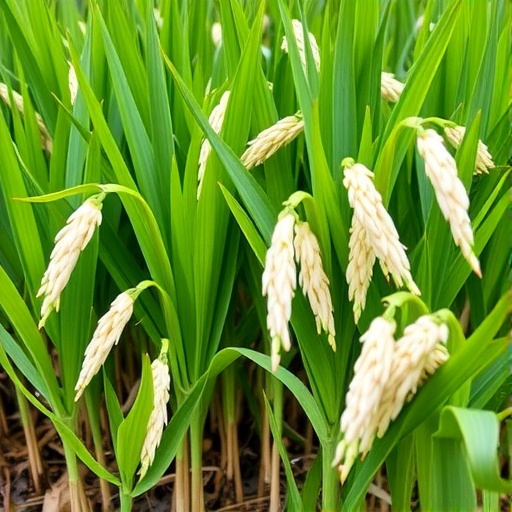A Groundbreaking Leap in Rice Cultivation: CRISPR/Cas9 Editing of GS9 Gene Enhances Japonica Grain Quality
In the ever-evolving landscape of agricultural biotechnology, the recent breakthrough in manipulating the GS9 gene to improve rice grain appearance heralds a promising future for crop optimization. Rice, a dietary cornerstone for billions worldwide, especially in Asia, demonstrates considerable varietal diversity broadly classified as indica and japonica. Among these, japonica rice varieties are prized for qualities like grain consistency but often suffer from undesirable traits related to grain shape and chalkiness that impact both consumer appeal and milling efficiency. The latest study spearheaded by researchers at Yangzhou University, China, unveils how targeted knockout of the GS9 gene via CRISPR/Cas9 technology achieves rapid and substantial improvement in japonica rice grain morphology without compromising yield potential.
At the heart of this advancement lies a nuanced understanding of how grain shape intertwines with chalkiness, two critical determinants of rice quality. Chalkiness manifests as opaque white spots or regions within the rice kernel, significantly reducing visual and textural appeal while decreasing grain processing quality. The research underscores grain width as a pivotal factor influencing chalkiness, with broader grains typically exhibiting elevated chalkiness levels. Conversely, slender grains foster more optimized grain-filling pathways, translating to diminished chalkiness while maintaining or even enhancing yield performance. This observation sets the stage for genetic interventions that finely tune grain dimensional attributes.
The GS9 gene emerges as a key molecular player influencing grain shape, particularly in japonica cultivars. The conventional japonica varieties widely cultivated in China characteristically produce short, round grains, which are conducive to high yield but concurrently exhibit pronounced chalkiness. Such grain morphology, while advantageous in certain agronomic contexts, poses challenges for breeders and consumers seeking higher grain appearance quality. The research team embarked on engineering a CRISPR/Cas9-mediated knockout of this gene—termed gs9KO—to effectively remodel grain shape with an eye toward reducing chalkiness while safeguarding agronomic performance.
Employing precise genome-editing techniques, the scientists introduced null alleles of GS9 into diverse japonica genetic backgrounds, rigorously analyzing phenotypic outcomes across variable planting densities. Intriguingly, the gs9KO allele consistently moderated grain shape, guiding the transformation from short, wide grains towards more slender phenotypes. This morphological refinement was accompanied by striking reductions in grain chalkiness, observable across all tested japonica lines. The uniformity and repeatability of these effects illustrate the robustness of CRISPR/Cas9 editing as a molecular breeding strategy capable of circumventing the limitations imposed by conventional breeding methods reliant on natural genetic variation.
Importantly, the mechanistic underpinnings of grain filling and chalk accumulation appear intricately linked to the spatial dimensions conferred by GS9 expression. The knockout of GS9 likely alters cellular proliferation or expansion dynamics within the developing grain, fine-tuning the geometry to promote efficient starch deposition and reduce opaque regions. This precision-targeted genetic manipulation avoids the yield penalties often associated with slender grain traits, as the gs9KO plants maintained stable yield components despite notable alterations in kernel shape. Such yield resilience paves the way for rapid adoption in agronomic regimes demanding both quality and productivity.
Beyond grain morphology, the study addressed possible pleiotropic effects, such as changes in plant architecture. Plants harboring the gs9KO allele exhibited a marginal increase in leaf angle, a trait influencing photosynthetic light interception and potentially plant density recommendations. However, this shift did not translate into adverse impacts on final grain yield across a range of planting densities, highlighting the agronomic stability of the edited lines. This observation is critical for ensuring that genetic enhancements translate seamlessly into real-world cultivation systems without deleterious trade-offs.
The implications of leveraging CRISPR/Cas9-mediated gene editing for fine-tuning crop traits are profound. The GS9 gene knockout represents a paradigm shift in molecular breeding approaches, offering targeted, predictable, and swift modifications to agronomically important traits. Unlike traditional breeding, which can be protracted and constrained by existing genetic diversity, precise genome editing accelerates trait introduction directly within elite cultivars. This research exemplifies how molecular insights integrated with cutting-edge technologies can overcome persistent challenges in staple crop improvement.
Furthermore, the study provides a valuable resource by characterizing the allelic distribution of major grain size genes in contemporary japonica cultivars. The revelation that many share identical allelic configurations underscores the need for novel genetic variation unlocked through editing to break homogeneity bottlenecks. By introducing the gs9KO allele, breeders can diversify grain morphology profiles to meet evolving market demands and consumer preferences centered around grain aesthetics and culinary quality.
From a broader perspective, the success of this research reinforces the transformative role of investments in functional genomics and biotechnological tools in crop science. Supported by the Government of Jiangsu Province and the National Natural Science Foundation of China, such efforts drive innovation that aligns with global food security objectives. Enhancing staple crop quality without yield sacrifice is an essential component of sustainable intensification paradigms, aiming to feed growing populations amid land and resource limitations.
As this genome editing approach moves closer to field deployment, addressing regulatory, biosafety, and consumer acceptance factors will be paramount. The CRISPR/Cas9 knockout of GS9 lacks foreign DNA integration, positioning it favorably within regulatory frameworks differentiating genome editing from transgenic modification. Transparent communication of scientific rigor and safety alongside demonstrated benefits could facilitate broad adoption, delivering tangible improvements in rice quality to farmers and consumers alike.
In summation, the targeted knockout of the GS9 gene via CRISPR/Cas9 editing offers a rapid, efficient, and broadly applicable strategy to enhance the grain appearance quality of widely cultivated japonica rice varieties. By reshaping grain morphology and reducing chalkiness without compromising yield and agronomic stability, this advancement marks a milestone in molecular breeding. It embodies the fusion of genetic insight, innovative technology, and practical agronomy poised to elevate one of the world’s most crucial staple crops for future generations.
Subject of Research: Cells
Article Title: Rapid improvement of rice appearance quality by targeted knockout of the GS9 gene
Web References: http://dx.doi.org/10.1016/j.jia.2025.04.002
Image Credits: Zhang T et al.
Keywords: Agriculture, Plant sciences, Cell biology, Genetics, Microbiology, Molecular biology




